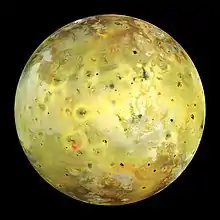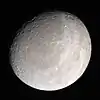အိုင်အို (ဂြိုဟ်ရံလ)
အိုင်အိုသည် ကြာသပတေးဂြိုဟ်ကို ပတ်၍နေသော ဂယ်လီလီယို၏ လများ ၄ စင်းရှိသည့်အနက်မှ အတွင်းဘက်အကျဆုံးလမ်းကြောင်းတွင် ပတ်၍နေသော ဂြိုဟ်ရံလတစ်ခုဖြစ်သည်။ နေအဖွဲ့အစည်းတွင်ရှိသော ဂြိုဟ်ရံလများထဲမှ စတုတ္ထမြောက်အကြီးဆုံး ဂြိုဟ်ရံလတစ်ခုလည်း ဖြစ်သည်။ ထိုမျှမကသေး ဂြိုဟ်ရံလအားလုံးတွင်လည်း သိပ်သည်းမှု အမြင့်ဆုံးလတစ်ခုလည်း ဖြစ်သည်။ အိုင်အိုကို ၁၆၁၀ ခုနှစ်တွင် ရှာဖွေတွေ့ရှိခဲ့ပြီး ဂရိဒဏ္ဍာရီထဲမှ ဟီရာနတ်ဘုရားမကို ကိုးကွယ်သူဖြစ်ပြီး နောင်တွင် ဇုစ်နတ်မင်းကြီး၏ အချစ်တော်ဖြစ်လာသူ အိုင်အိုမင်းသမီးကို အစွဲပြု၍ မှည့်ခေါ်ခဲ့သည်။
 Galileo spacecraft true-color image of Io. The dark spot just left of the center is the erupting volcano Prometheus. The whitish plains on either side of it are coated with volcanically deposited sulfur dioxide frost, whereas the yellower regions contain a higher proportion of sulfur. | |||||||||
| ရှာဖွေတွေ့ရှိခြင်း | |||||||||
|---|---|---|---|---|---|---|---|---|---|
| ရှာဖွေတွေ့ရှိခဲ့သူ | ဂယ်လီလီယို | ||||||||
| ရှာဖွေတွေ့ရှိသည့် ရက်စွဲ | ၈ ဇန်နဝါရီ ၁၆၁၀[1] | ||||||||
| အသံထွက် | /ˈaɪ.oʊ/[2] | ||||||||
အခြားအမည်များ | Jupiter I | ||||||||
| ပါဝင်အရာဝတ္ထုများ | Ionian | ||||||||
| ပတ်လမ်း ဂုဏ်အင်များ | |||||||||
| Periapsis | 420000 km (0.002807 AU) | ||||||||
| Apoapsis | 423400 km (0.002830 AU) | ||||||||
ပျမ်းမျှ ပတ်လမ်းအချင်းဝက် | 421700 km (0.002819 AU) | ||||||||
| ပတ်လမ်း ဗဟိုကျမှု | 0.0041 | ||||||||
ပတ်လမ်း ကာလ | 1.769137786 d (152853.5047 s, 42.45930686 h) | ||||||||
ပျမ်းမျှ ပတ်နှုန်း | 17.334 km/s | ||||||||
| ပတ်လမ်း တိမ်းစောင်းမှု | 0.05° (to Jupiter's equator) 2.213° (to the ecliptic) | ||||||||
| ဂြိုဟ်ရံလများ | ကြာသပတေးဂြိုဟ် | ||||||||
| ရုပ်ပိုင်းဆိုင်ရာ ဂုဏ်အင်များ | |||||||||
| ဒိုင်မင်းရှင်း | 3,660.0 × 3,637.4 × 3,630.6 km[3] | ||||||||
ပျမ်းမျှ အချင်းဝက် | 1821.6±0.5 km (0.286 Earths)[4] | ||||||||
မျက်နှာပြင် ဧရိယာ | 41910000 km2 (0.082 Earths) | ||||||||
| ထုထည် | 2.53×1010 km3 (0.023 Earths) | ||||||||
| အရွယ်အစား | (8.931938±0.000018)×1022 kg (0.015 Earths)[4] | ||||||||
ပျမ်းမျှ သိပ်သည်းဆ | 3.528±0.006 g/cm3[4] | ||||||||
မျက်နှာပြင် ဒြပ်ဆွဲအား | 1.796 m/s2 (0.183 g) | ||||||||
အင်နားရှားကိန်း | 0.3755±0.0045[5] (estimate) | ||||||||
လွတ်မြောက်အလျင် | 2.558 km/s | ||||||||
လှည့်ပတ်ကာလ | synchronous | ||||||||
အီကွေတာ လည်ပတ်မှု အလျင် | 271 km/h | ||||||||
| Albedo | 0.63±0.02[4] | ||||||||
| |||||||||
မြင်သာသော အရွယ်အစား | 5.02 (opposition)[7] | ||||||||
| လေထု | |||||||||
မျက်နှာပြင် လေထုဖိအား | trace | ||||||||
| လေထု၌ ဓာတုပါဝင်နှုန်း | 90% ဆာလဖာဒိုင်အောက်ဆိုဒ် | ||||||||
မီးတောင်ရှင်ပေါင်း ၄၀၀ ကျော်နှင့် အိုင်အိုဟာ နေအဖွဲ့အစည်းအတွင်း၌ မြေမျက်နှာသွင်ပြင်အရ လှုပ်ရှားမှုအများဆုံး အရာတစ်ခုဖြစ်သည်။[8][9] ဤကဲ့သို့ မြေမျက်နှာသွင်ပြင်အရ အလွန်အမင်းလှုပ်ရှားမှုများနေရခြင်းသည် အပူဒီလှိုင်းများကြောင့်ဖြစ်ပြီး ထိုဒီလှိုင်းတို့သည် အိုင်အိုင်၏ အတွင်းပိုင်းနှင့် ကြာသပတေးဂြိုဟ်နှင့် အခြားသော ဂယ်လီလီယိုလများဖြစ်သည့် ယူရိုပါ၊ ဂန်မီဒီ၊ ကယ်လီစတိုတို့အကြား ဆွဲအားများကြောင့် ထွက်ပေါ်လာရခြင်း ဖြစ်သည်။ အချို့သော မီးတောင်များမှ ဆာလဖာ နှင့် ဆာလဖာဒိုင်အောက်ဆိုဒ် ဓာတ်ငွေ့များ၊ အရည်များဟာ မျက်နှာပြင်မှ ကီလိုမီတာ ၅၀၀ ခန့်အထိ ပန်းထွက်လို့နေပြီး မီးတောင်များပေါက်ကွဲခြင်းကြောင့် ဖြစ်ပေါ်လာတဲ့ တောင်ပူစာပေါင်းကလည်း ၁၀၀ ကျော်လောက် ရှိပါသည်။ အချို့တောင်များသည် ကမ္ဘာပေါ်က ဧဝရတ်တောင် ထက်တောင် မြင့်မားကြသည်။[10] အခြားသော ဂြိုဟ်ရံလများကဲ့သို့ ရေ၊ ရေခဲတို့ဖြင့် အဓိကဖွဲ့စည်းထားခြင်းမဟုတ်ပဲ အိုင်အိုသည် ဆီလီကိတ်ကျောက်တုံးများ(silicate rock)ဖြင့် ဗဟိုချက်မဖြစ်သည့် သံရည်ပူ(molten iron) (သို့) အိုင်ရင်း-ဆာဖိုက်(iron-sulfide) ဗဟိုကို ဝန်းရံဖွဲ့စည်းထားသည်။ အိုင်အို၏ မျက်နှာပြင်တွင် ကျယ်ပြန့်သော လွင်ပြင်များလည်းရှိပြီး ဆာဖာနှင့် ဆာဖာဒိုင်အောက်ဆိုဒ် အမှုန်များဖြင့် ဖုံးလွှမ်း၍ နေသည်။
အိုင်အိုသည် ၁၇ ရာစုနှင် ၁၈ ရာစု၏ နက္ခတ္တဗေဒပညာရပ် တိုးတက်ပြောင်းလဲမှုအတွက် အဓိကကျသော အခန်းကဏ္ဍတွင် ပါဝင်ခဲ့သည်။ ၁၆၁၀ ခုနှစ် ဇန်နဝါရီလတွင် ဂယ်လီလီယိုမှ အခြားသော ဂယ်လီလီယို လများနှင့်အတူ တွေ့ရှိခဲ့ခြင်းဖြစ်သည်။ ထိုသို့တွေ့ရှိခဲ့မှုသည် ကော်ပါးနိကပ်စ်၏ နေဗဟိုပြုသီအိုရီအား သက်သေပြမှု၊ ကပ်ပလာ၏ ရွေ့လျားမှုဥပဒေသနှင့် အလင်းအလျင်ကို ပထမဆုံးအကြိမ်တွက်ချက်ခြင်းတို့အတွက် အထောက်အပံ့ဖြစ်စေခဲ့သည်။ ကမ္ဘာမှနေလျှင် အိုင်အိုကို အလင်းစက်လေးအဖြစ် ၁၉ ရာစုနှောင်းပိုင်းနှင့် ၂၀ ရာစုအစောပိုင်းကာလအထိ သိရှိခဲ့ရပြီး နှောင်းပိုင်းမှသာ အနီရင့်ရောင် ဝန်ရိုးစွန်းများ၊ အလင်းတောက်နေသော အီကွေတာ ဒေသများဖြင့် သူ၏ မျက်နှာပြင်ကို အကြီးချဲ့ သရုပ်ခွဲနိုင်ခဲ့သည်။ ၁၉၇၉ ခုနှစ်တွင် ဗွိုင်ယေဂျာ အာကာသယာဉ်နှစ်စီး ထုတ်လွှင့်သော အချက်အလက်များအရ အိုင်အိုသည် များလှစွာသော မီးတောင်များ၊ ကြီးမားသော တောင်များရှိပြီး ဥက္ကာခဲများဖြင့် ထိခိုက်မှုကြောင့်ဖြစ်သော ချိုင့်ဝှမ်းကြီး (မီးတောင်ဝ)တို့ မရှိသည့် မြေမျက်နှာပြင်အစရှိသော မြေမျက်နှာသွင်ပြင်ဆိုင်ရာ လှုပ်ရှားမှုများရှိသည့် ကမ္ဘာတစ်ခုအဖြစ် ထုတ်ဖော်နိုင်ခဲ့သည်။ ဂယ်လီလီယို အာကာသယာဉ်၏ ၁၉၉၀ ခုနှစ်များမှ ၂၀၀၀ ခုနှစ်များအထိ အနီးကပ်ဖြတ်၍ ပျံသန်းခြင်းများကြောင့် အိုင်အို၏ အတွင်းပိုင်းတည်ဆောက်ပုံနှင့် မျက်နှာပြင်ဖွဲ့စည်းပုံ အချက်အလက်များ ရရှိခဲ့သည်။ ဤအာကာသယာဉ်မှ ထုတ်ပြန်သော အချက်အလက်များအရ အိုင်အိုနှင့် ကြာသပတေးဂြိုဟ်တို့၏ သံလိုက်စက်ကွင်းများ(magnetosphere)အကြား ဆက်နွယ်မှုနှင့် ခါးပတ်ကွင်းများ၏ စွမ်းအင်မြှင့်ဖြာထွက်မှု(high-energy radiation)သည် အိုင်အို၏ပတ်လမ်းပေါ် ဗဟိုချက်အဖြစ်တည်ရှိနေမှုတို့ကို ဖော်ထုတ်နိုင်ခဲ့သည်။ အိုင်အိုသည် တနေ့လျှင် အိုင်းရင်းဖြာထွက်မှု(ionizing radiation)ကို ၃,၆၀၀ rem (၃၆ Sv) ကို လက်ခံရရှိနေသည်။[11]
နောက်ထပ်သော လေ့လာမှုများကို ကာစီနီ-ဟိုင်ဂင်အာကာသယာဉ်ဖြင့် ၂၀၀၀ ခုနှစ်တွင် လည်းကောင်း၊ New Horizons အာကာသယာဉ်ဖြင့် ၂၀၀၇ ခုနှစ်တွင်လည်းကောင်း၊ ကမ္ဘာဂြိုဟ်အခြေပြု တယ်လီစကုပ်များနှင့်လည်းကောင်း၊ ဟပ်ဘယ် အာကာသ တယ်လီစကုပ်ဖြင့်လည်းကောင်း ပြုလုပ်ခဲ့ကြပါသည်။
ကိုးကား
- EYE-oh, or as ဂရိ: Ἰώ
- Thomas, P. C. (1998). "The Shape of Io from Galileo Limb Measurements". Icarus 135 (1): 175–180. doi:. Bibcode: 1998Icar..135..175T.
- Yeomans၊ Donald K. (13 July 2006)။ Planetary Satellite Physical Parameters။ JPL Solar System Dynamics။
- "The Galilean Satellites" (October 1999). Science 286 (5437): 77–84. doi:. PMID 10506564.
- Rathbun, J. A. (2004). "Mapping of Io's thermal radiation by the Galileo photopolarimeter-radiometer (PPR) instrument". Icarus 169 (1): 127–139. doi:. Bibcode: 2004Icar..169..127R.
- Classic Satellites of the Solar System။ Observatorio ARVAL။ 28 September 2007 တွင် ပြန်စစ်ပြီး။
- Rosaly MC Lopes (2006)။ "Io: The Volcanic Moon"။ in Lucy-Ann McFadden; Paul R. Weissman; Torrence V. Johnson (eds.)။ Encyclopedia of the Solar System။ Academic Press။ pp. 419–431။ ISBN 978-0-12-088589-3။
- Lopes, R. M. C. (2004). "Lava lakes on Io: Observations of Io’s volcanic activity from Galileo NIMS during the 2001 fly-bys". Icarus 169 (1): 140–174. doi:. Bibcode: 2004Icar..169..140L.
- Schenk, P. (2001). "The Mountains of Io: Global and Geological Perspectives from Voyager and Galileo". Journal of Geophysical Research 106 (E12): 33201–33222. doi:. Bibcode: 2001JGR...10633201S.
- 2000 February 29, SPS 1020 (Introduction to Space Sciences)။ CSUFresno.edu (29 February 2000)။ 20 September 2009 တွင် မူရင်းအား မော်ကွန်းတင်ပြီး။
ပြင်ပလင့်များ
![]() Wikimedia Commons ရှိ အိုင်အို နှင့်ပတ်သက်သော မီဒီယာများ
Wikimedia Commons ရှိ အိုင်အို နှင့်ပတ်သက်သော မီဒီယာများ
အထွေထွေအချက်အလက်များ
- Io Profile at NASA's Solar System Exploration site
- Bill Arnett's Io webpage from The Nine Planets website
- Io overview Archived 13 April 2010 at the Wayback Machine. from the University of Michigan's Windows to the Universe Archived 13 April 2010 at the Wayback Machine.
- Calvin Hamilton's Io page from the Views of the Solar System website
ရုပ်ရှင်များ
- Paul Schenk's 3D images and flyover videos of Io and other outer solar system satellites
- High resolution video simulation of rotating Io by Seán Doran
ပုံများ
မြေပုံများ
- Io global basemaps from the USGS's planetary geology website based on Galileo and Voyager images
- Io nomenclature and Io map with feature names from the USGS planetary nomenclature page
- Interactive map of Io by Google Maps
ထပ်တိုးရည်ညွှန်းများ
- Io dynamo from educational website The Exploration of the Earth's Magnetosphere
- The Conundrum Posed by Io's Minimum Surface Temperatures
- Io Mountain Database
- Paul Geissler's research on Cassini observations of Io's visible aurorae Archived 18 October 2011 at the Wayback Machine.
- The Gish Bar Times, Jason Perry's Io-related blog
